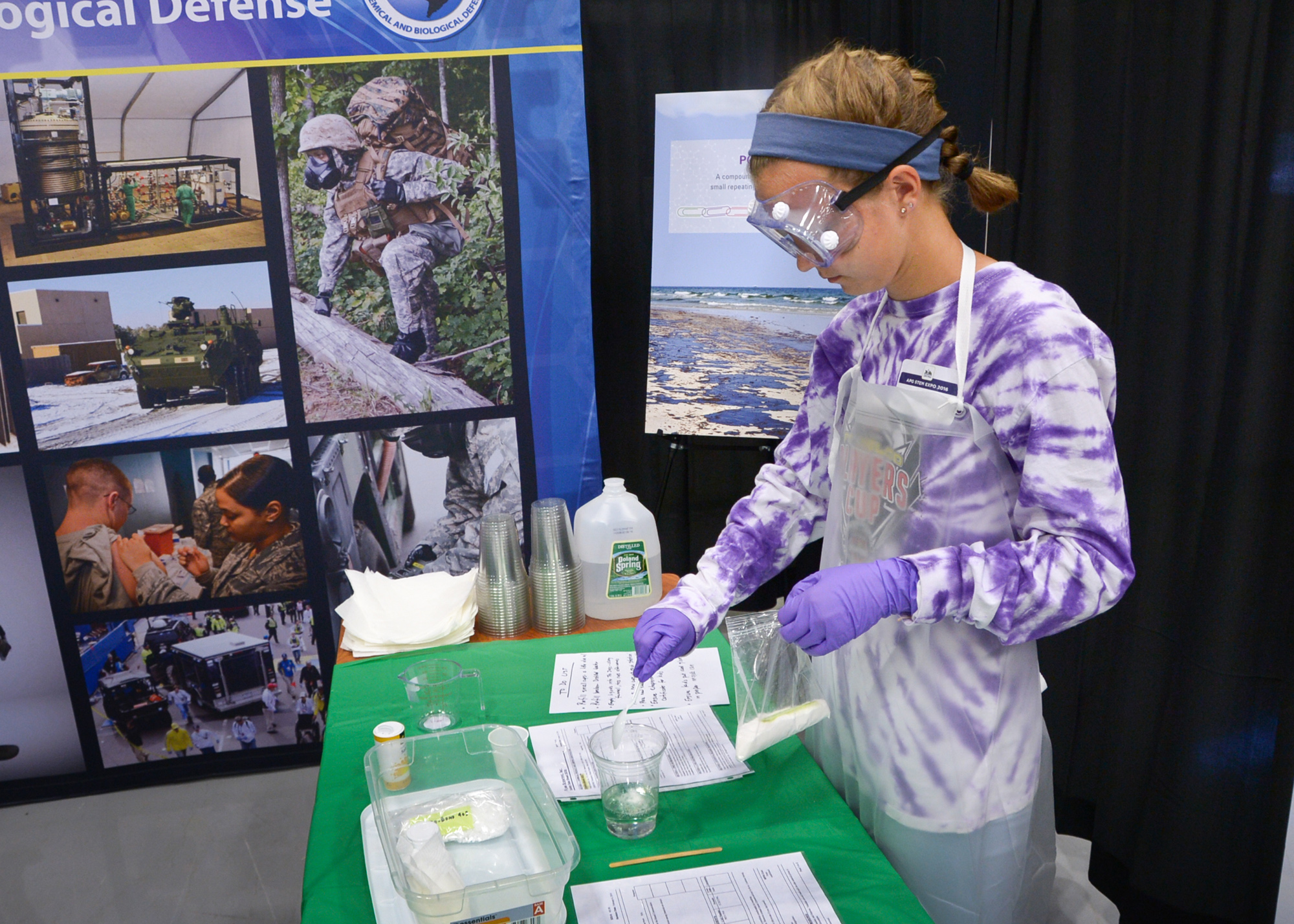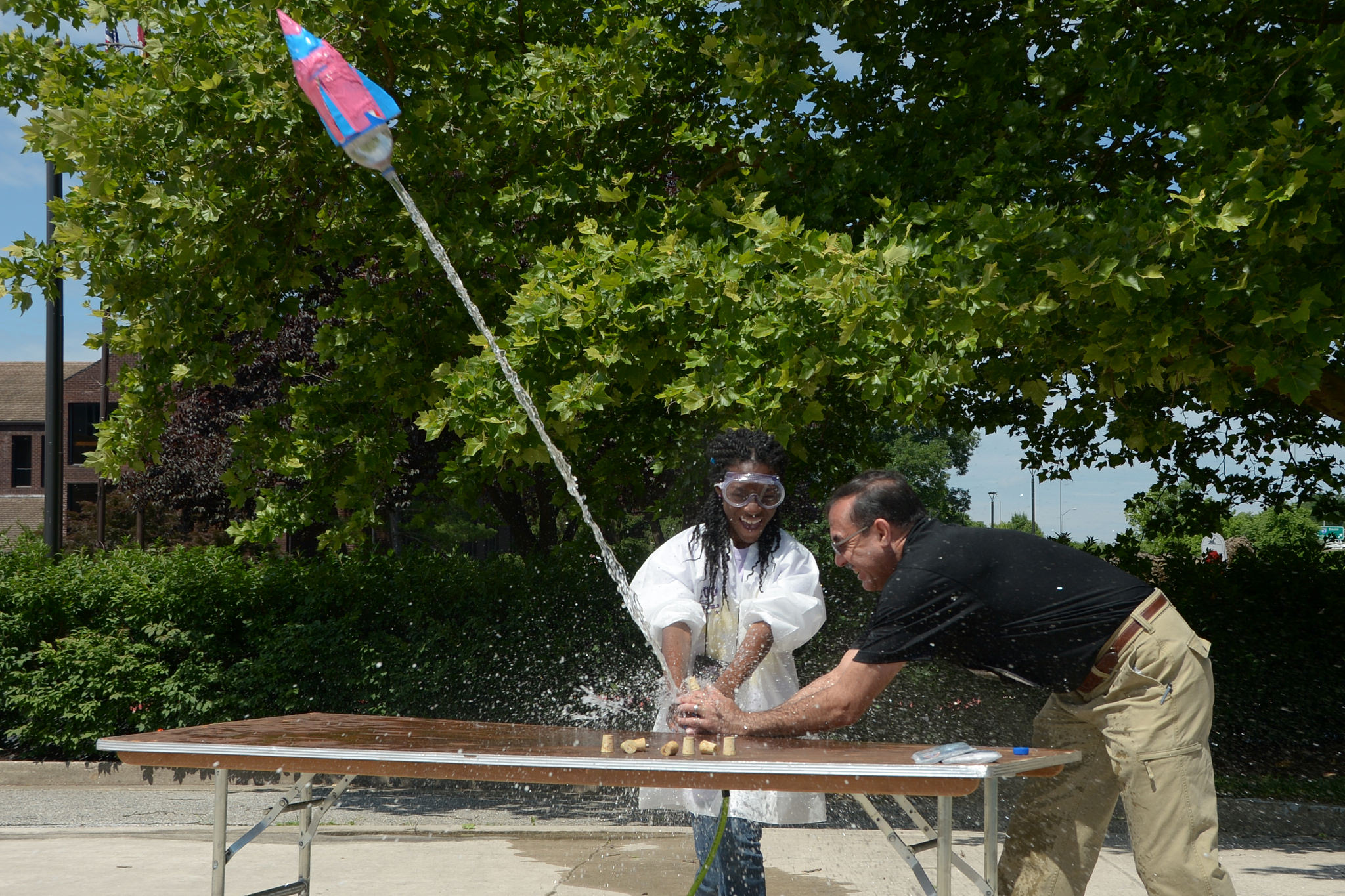
HAPPENING NOW: SCIENCE
A student conducts an experiment at a 2016 STEM Expo held at Aberdeen Proving Ground (APG), Maryland. The Army’s efforts to encourage STEM literacy are multipronged, including one-day events like the expo along with ongoing mentorship. Numerous organizations in the APG community meet to collaborate, discuss upcoming events and share best practices in STEM outreach and education. (Photo by Conrad Johnson, RDECOM)
RDECOM’s STEM outreach program targets students from kindergarten to college
by Ms. Argie Sarantinos-Perrin
Knocking down a stack of blocks, then backing up to switch directions, a robot effortlessly moves around a local school as a group of children watch and wait for their turn to operate the remote control. The children marvel at the hodgepodge of whirring motors, nuts and bolts, the culmination of their hard work in a science, technology, engineering and mathematics (STEM) robotics competition.
Through STEM experiences, competitions and research apprenticeships, the Army Educational Outreach Program (AEOP)—managed by the U.S. Army Research, Development and Engineering Command (RDECOM) on behalf of the assistant secretary of the Army for acquisition, logistics and technology—offers an array of educational opportunities for children from kindergarten through college. As a major subordinate command of the U.S. Army Materiel Command, RDECOM is working with AEOP and its academic and industry partners to develop the workforce of the future.
“Even if students don’t go into a traditional science or mathematics field, formal and informal STEM education helps children develop problem solving and critical thinking skills that will help them in any career field,” said Louie Lopez, chief of RDECOM human capital planning and development and STEM education outreach. “One of our goals is to get children excited about math and science, beginning in kindergarten, so that it will hopefully carry through high school and into college.”

SPLASH, ZOOM: Alfredo Ramirez, a volunteer from the U.S. Army Test and Evaluation Command, helps Ayrika Anderson from White Station Middle School, Memphis, Tennessee, at a recent eCybermission event. Army volunteers are key to the success of the AEOP—in 2016, more than 800 helped mentor competitors and judge solutions to community problems in the “world’s largest online science fair.” (Photo by Conrad Johnson, RDECOM)
According to the 2015 results of the Program for International Student Assessment (PISA), students in the United States scored 496 in science literacy—lower than 18 education systems worldwide. Students in Singapore had the highest score, 556, and the Dominican Republic the lowest, 332.
The PISA, which is administered to 15-year-old students every three years, evaluates education systems worldwide in science, mathematics, reading, collaborative problem solving and financial literacy. More than a half-million students in 72 countries took the two-hour test in 2015. The Organization for Economic Cooperation and Development, which promotes economic growth, prosperity and sustainable development, sponsors PISA.
Mathematics literacy is even lower for students in the United States. Students scored 470, placing them squarely in the middle, below 36 other education systems. Students in Singapore again earned the highest score, 564, and students in the Dominican Republic again had the lowest, 328.
The Army has supported STEM educational opportunities for more than 50 years. While previous efforts were funded through grants and contracts, AEOP, which was formed in 2004, awarded a cooperative agreement award in 2010 to ensure a cohesive and collaborative approach to its programming, leveraging expertise from academia, industry and nonprofit organizations. In 2015, AEOP re-competed the cooperative agreement. The new cooperative agreement was awarded to Battelle and its consortium partners from academia, industry and non-profit organizations. RDECOM represents the Army science and technology community on the AEOP consortium on behalf of the deputy assistant secretary of the Army for research and technology.
“One of my first events was a STEM night in Cecil County, Maryland, where I saw folks from across the command giving a demo with a hands-on experiment,” said Juju Hewitt, former RDECOM executive deputy to the commanding general. “To see and feel that energy is so uplifting, and these one-day STEM events are key to promoting a more sustained STEM engagement such as AEOP.” Hewitt, who recently retired from government service after 38 years, had oversight of the Army STEM program when he joined RDECOM in 2013.
AEOP activities rely on adult participation, including Army scientists and engineers who serve as mentors, judges, presenters and teachers. In 2016, these mentors worked in STEM events with almost 31,000 AEOP students in the U.S., Europe, Asia, Australia, American Samoa, Guam and the Virgin Islands, as well as military dependents from DOD Educational Activity international schools, which are run by or sponsored by the DOD, based on the number of military dependents who attend those schools.
“Engaging world-class scientists and engineers who work in our state-of-the-art research laboratories and engineering centers to mentor AEOP activities is a unique aspect that the Army offers to STEM education,” said Lopez. Students often work alongside Army engineers and scientists in labs on research projects. Many of the 135 universities and colleges that partner with AEOP offer research apprenticeships that expose students to unique STEM learning experiences.
RDECOM, based at Aberdeen Proving Ground (APG), Maryland, also collaborates with local STEM efforts like the Defense Threat Reduction Agency’s Joint Science and Technology Institute, a two-week residential research program that enables high school students and select teachers to work in world-class labs at APG. The Communications-Electronics Research, Development and Engineering Center at APG offers real-world paid internships in science and engineering for students who are 16 or older. At the end of their internship, the students, who work with professional engineers and scientists, present their research to APG leadership and local industry partners.
In addition to educating students about fundamental STEM skills, there are other benefits to mentoring, including teaching children about the science culture and the importance of honesty, integrity and objectivity in scientific research. It also teaches children how to compete; many of the programs, such as AEOP’s eCybermission competition, are competed at state, regional and national levels.

THE VICTORIOUS CHICAS: From left to right, Jyuji Hewitt, Frank Bohn, Ingrid Rapatz-Roettger, Janat Khan, Luz Figueroa-Rodriguez, Janeliz Guzman Acevedo, Bria Roettger, Sgt. 1st Class Jose Roldan, Command Sgt. Maj. James Snyder and Sgt. 1st Class Ernest Robledo. Khan, Figueroa-Rodriguez, Acevedo and Roettger, sixth-graders from Puerto Rico, make up Team Las Chicas and won the eCybermission national competition in 2016 for their work on an interactive website that serves as a warning system for people in their community who suffer with respiratory issues from the effects of Saharan dust. (U.S. Army photo)
ECybermission, a web-based STEM competition for students in grades six through nine, is one of the AEOP’s largest efforts. Dubbed the “world’s largest online science fair,” the program, which is in its 14th year, involved 20,607 students and 802 team advisers in 2016. Using either a scientific method or the engineering design process, teams of three or four students propose a solution to a real problem in their communities and compete for state, regional and national awards and recognition.
In 2016, a team of sixth-graders from Puerto Rico won the eCybermission national competition for their work on an interactive website that serves as a warning system for people in their community who suffer with respiratory issues from the effects of Saharan dust. (Trade winds blow dust from the Sahara Desert approximately 7,000 miles to Puerto Rico and other areas, carrying fungi and other particles that affect people with respiratory issues like asthma.) The four-girl team worked with the National Oceanic and Atmospheric Administration to observe and analyze the current Saharan dust levels through satellite data or imagery. They used the information to create graphs, essays and surveys, which were shared online with their local community.
ECybermission is administered by the National Science Teachers Association (NSTA), which is a member of the AEOP consortium. The NSTA works with science teachers to define the next generation of each state’s math and science standards and mission objectives, as well as common core standards that outline what students should know and be able to do at the end of each grade in mathematics and language arts.

SCOUTS DO STEM: At APG’s annual STEM in Scouting Day, scouts have an opportunity to earn merit badges in various STEM categories. APG volunteers, including scientists, engineers and chemists, work with the scouts to cultivate critical thinking skills that will enable them to be more competitive in the workforce. (Photo by Tom Faulkner, RDECOM)
At the conclusion of eCybermission 2016, Purdue University, which conducts AEOP evaluations year-round, issued a report that addressed questions related to the program’s strengths and challenges, benefits to participants and the overall effectiveness in meeting AEOP objectives. The report was compiled using student and team adviser questionnaires, student and team adviser focus groups, observations of the national judging and educational event and the eCybermission annual report.
Purdue is also conducting a longitudinal study to evaluate the impact of AEOP on participants’ professional careers, as well as their career path over five to seven years. According to this year’s report, 97 percent of AEOP alumni are interested in pursuing STEM careers, and 52 percent remain connected with their mentor after their AEOP experience has ended.
Students are also measured on their knowledge of Army and DOD STEM careers. “Students often believe that they need to join the Army and become a Soldier to have a government career, so part of the outreach involves educating the general public about the various student opportunities in STEM, the great work that our civilian scientists and engineers do in support of our Soldiers and our nation, and the various government career paths and job opportunities,” said Lopez.
CONCLUSION
While the Army has responded to the critical need for an agile and resilient STEM workforce, diversity remains an issue. According to the Purdue 2016 eCybermission report, gender distribution was balanced—49 percent of participants were male and 51 percent were female. Ethnicity, however, was unbalanced—49 percent of the participating students were white, 18 percent were Latino and 8 percent were African-American.

HANDS-ON LEARNING: Boy Scouts from Maryland and surrounding states participate in the October 2016 STEM in Scouting Day at Aberdeen Proving Ground, the largest scouting STEM event of its kind in the nation held on a military installation. Even if event participants don’t go on to careers in STEM or with the military, AEOP’s outreach helps build literacy in science and math, where U.S. students trail their peers in other countries. (Photo by Tom Faulkner, RDECOM)
The Army is working to close the minority gap with events such as the annual Black Engineer of the Year Awards (BEYA) and the Hispanic Engineer National Achievement Awards Corp. During the 2017 BEYA, more than 100 scientists and engineers from DOD received awards and special recognition honors. The BEYA conference also teaches students about STEM careers in all service branches and encourages young professionals who attend the event to network with recruiters.
Networking may be key to hiring professionals with strong STEM skills to fill vacancies that may occur in the next five years, when close to 40 percent of the RDECOM workforce is eligible to retire. “We need to be heavily invested in building the future talent to allow the Army, the Department of Defense and the defense industrial base to have enduring access to homegrown U.S. talent,” said Lopez.
For more information, go to www.usaeop.com.
MS. ARGIE SARANTINOS-PERRIN, a public affairs specialist for Huntington Ingalls Industries – Technical Solutions Division, provides contract support to RDECOM. She holds an M.S. in professional writing and a B.A. in mass communications from Towson University. She has 11 years of public affairs experience supporting DOD.
This article is scheduled to be published in the July-September 2017 issue of Army AL&T Magazine.Read the full article in the Spring 2021 issue of Army AL&T magazine.
Subscribe to Army AL&T – the premier source of Army acquisition news and information.
![]()







